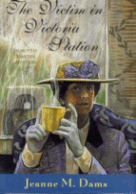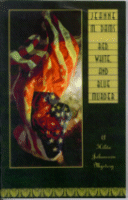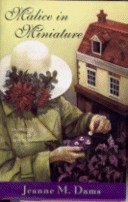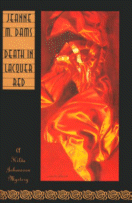A Conversation With Jeanne M. Dams
by Claire E. White
Jeanne M. Dams, an Indiana native with degrees from Purdue and Notre Dame, is the author of five mystery novels starring Dorothy Martin, an American widow living and sleuthing in England. The first book in the series, The Body in the Transept, was a nominee for the

|
Jeanne loves hats, cats, dollhouses, England, Jack Daniel's, and almost anything that's out of date: old movies, steam trains, antiques, Victoriana. The latter interest led to her second series, historical mysteries set in her home town of South Bend at the turn of the last century. The first book in that series, Death in Lacquer Red, stars strong-willed young Hilda Johansson, a Swedish immigrant and the head housemaid at Tippecanoe Place, the Studebaker mansion. The second, Red, White and Blue Murder, involves Hilda in distressing events surrounding the assassination of President McKinley, has just been released by Walker & Co.
Jeanne is working on the next historical book (which does not as yet have a title) the seventh Dorothy Martin, a thriller, and several nonfiction books. In her copious spare time in between book tours, Jeanne looks after her house, her husband, several cats, and the interests of the Mystery Writers of America, of whose Midwest Chapter she is president. Although she loves things historical, Jeanne is decidedly modern in some of her habits; she loves the Internet and uses it for research and for keeping up with friends and fans. We talked to Jeanne about her move from teacher to novelist, and how she created her two popular mystery series.
When did you first know that you wanted to be a writer?
I'm not sure I ever did, in the sense of a blinding flash of "This is my vocation." I was looking for something to replace the killer job I had, and realized that the thing I most enjoyed and was very good at was writing. I didn't know if I could write fiction, but decided to try, since mysteries were my favorite form of reading.
What did you enjoy most about teaching? What subjects did you teach?
What did I enjoy most? The summer vacations! I was a poor teacher, mostly because I have little patience. I taught in elementary school, various grades. The only year I enjoyed was one fourth grade in California, where I was team-teaching and got to work with another adult. It was good for American's children that I got out of the profession.
What led up to your first novel, The Body in the Transept, being published?
| "I have to try to be historically accurate about such things without offending my readers, and it isn't always easy, especially since many readers assume that a character's attitudes are those of the author." |
Were you at all surprised the book's being nominated for the Macavity and winning the Agatha Award for best novel?
Surprised and thrilled!
How did you create the character of Dorothy? Were there any specific traits or personality traits that you wanted to avoid with this character?
Dorothy created herself. She's me, essentially. (Okay, she is I, but may I be ungrammatical and colloquial for a moment?) She's older than I am, and nicer, but essentially, if you know one of us, you know the other. By now, though, she is herself, and I couldn't change her if I wanted to.
In Malice in Miniature, Dorothy Martin becomes involved in the world of dollhouses. How did you get interested in dollhouses? Do you have a collection yourself?
I have a dollhouse, have had ever since I was a little girl. (Although my old one disappeared. I don't know what my mother did with it, but it's gone forever, along with nearly all its furniture.) My current one isn't anything like finished, but I have a pretty complete set of furnishings for it, including a lot of Petite Princesse stuff from the sixties that my agent gave me. All you collectors out there, please don't drool on your keyboards.
Let's talk about the latest Dorothy Martin mystery, The Victim in Victoria Station. What was your inspiration for Dorothy's latest adventure?

|
This latest book centers on the software industry and the Internet. How did you approach the research needed for this story?
I had one big asset: my niece is a corporate attorney for Apple and can come up with all the answers. I was also lucky enough to be sitting, with my husband, next to a table full of computer nerds in a restaurant one night. I'm a devout eavesdropper, so when I heard their conversation I knew they were just the guys to ask about some stuff. They were a little surprised, I think, when this peculiar woman in a hat accosted them, but they gave me a lot of useful information.
How has Dorothy Martin developed over the course of the series?
She's become more sure of herself, I think, and certainly happier now that Alan has come along to brighten her life. She hasn't changed a lot, though. One's character is pretty well fixed by her stage of life.
What's next for Dorothy?
I don't know in which order, but the next two books are going to involve murder in a local school in Sherebury (a public school in the American sense of the term) and skullduggery of some sort set amongst the smugglers' caves in Cornwall. (I had to have some excuse to visit there and pig out on Cornish pasties and clotted cream.)
Your other series stars Hilda Johannson and is set in 1900s Indiana. This is a very different series than the Dorothy Martin series. How did this series come into being?

|
Hilda is an interesting heroine. How did you create the character of Hilda?
I don't know, actually. I wanted her to be a housemaid, I knew she would be Swedish (because she actually would have been, probably), and I knew she was stubborn. (My mother was of Swedish descent.) The rest just developed.
Hilda works in the grand home of the Studebaker family. How did you decide on using the Studebakers as Hilda's employers?
Two reasons. The first is that the mansion, Tippecanoe Place, still exists and was easy to research. The second is that the Studebaker name is well enough known, and enough people have visited Tippecanoe Place while in town for football games--it's a restaurant now--that I knew there'd be some name recognition.
How did you approach the research necessary for this series? Do you use the Internet for research at all?
| "Writers' groups are another matter. A good one can be invaluable. A bad one can kill you. My first one almost did." |
The latest Hilda Johannson book is Red, White and Blue Murder. How did this book come about?
I wanted to base the book on a real historic event and keep it in chronology, which would place it in 1901. The most important world event in 1901 was the assassination of President McKinley. Since he actually had some South Bend ties, it seemed logical to build the book around his death.
In South Bend, Indiana in 1900, the attitudes towards foreigners, minorities and women were much different than they are in the South Bend of 2000. What challenges or decisions did this fact present to you in writing this series?
I'm having to walk a fine line here. I want to present the attitudes as they existed. But I'm writing for an audience to whom such attitudes are repugnant. I have to try to be historically accurate about such things without offending my readers, and it isn't always easy, especially since many readers assume that a character's attitudes are those of the author.
When writing about real historical personages and places, what issues have you faced as to what elements to fictionalize?
I've tried to keep the characters and personalities of the real people as they were, so far as we know what they were. I've felt free to invent speeches and incidents, however. I've left real places as they were, but again, felt free to make things happen in those places that never really did. So, in Red, White, and Blue Murder, the City Hall that's being built is real. Nobody was ever really murdered on that building site, however.
I'd like to talk about the details of writing. What is a typical workday like for you?

|
When starting a new book, do you use outlines? How much of the plot do you know before you sit down to write?
I used to outline pretty extensively. Now I don't outline until I get stuck. These days, a basic idea for a situation can get me started. Characters seem to walk in as needed and plot elements obligingly unfold. I'm twenty pages into the new Hilda right now, and don't have the slightest idea who the villain is, or even why the murder happened. It scares me, but so far it feels okay.
How useful do you think writer's groups and conferences are for the beginning writer?

|
What is the strangest thing that has happened to you on a book tour? What advice do you have for a first-time author who is about to embark on her first book tour?
The scariest thing was getting lost in the Arizona desert with night coming on and no water in the car. I had no cell phone at the time and there was nothing but cactus, anywhere you looked. One piece of advice is, never rely on anybody's directions, no matter how reliable you think they are. Get a map. The other is to be prepared for an evening sitting and talking with the manager of the bookstore, especially if it's a chain. Sometimes you get lots of people, more often you don't. Libraries are a better bet, usually, than bookstores--again, especially chains.
What is your advice to the aspiring mystery author?
Don't quit your day job. And don't give up.
Return to the May 2000 issue of The IWJ.
More from Writers Write
